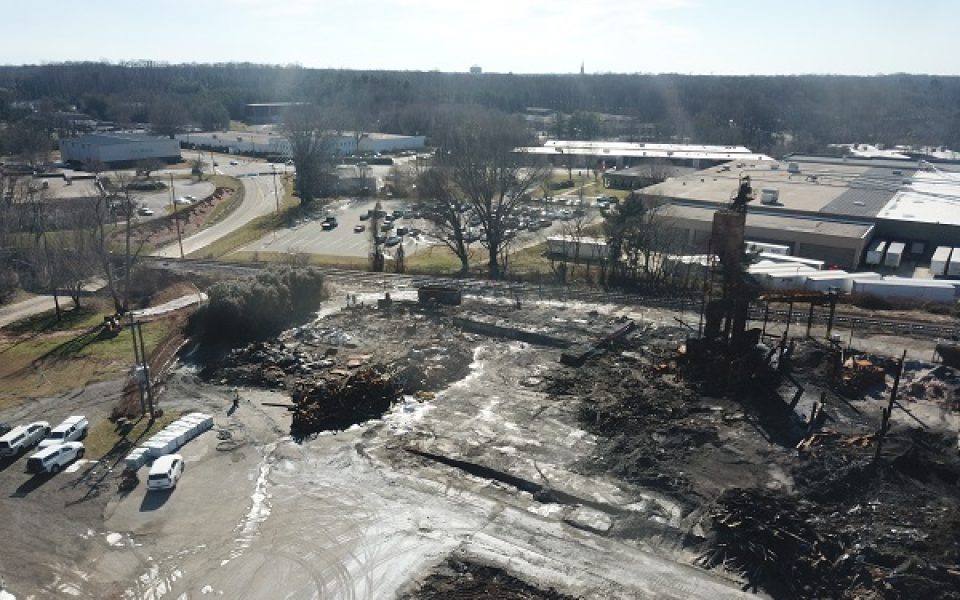This story was originally published by NC Policy Watch. Story by Lisa Sorg.

Holes gaped in the roof. Water leaked down the walls and onto the floor. Electrical fixtures routinely went on the fritz.
State documents show the extent of disrepair at the Weaver Fertilizer plant in Winston-Salem, conditions that could have contributed to a massive ammonium nitrate fire 13 months ago. The blaze burned for a week, destroyed the plant and compelled 6,500 people, fearing an explosion, to evacuate.
The Department of Labor provided photos and the documents, requested by Policy Watch last year under the state’s Public Records law.
Although the precise cause of the fire might never be known, a trifecta of water, electrical hazards and potentially explosive ammonium nitrate likely started the blaze.
“In addition to the electric short hazard, water seepage can create an explosion hazard,” state documents read. “If water is allowed to contaminate the ammonium nitrate pile, it may lump or cake together resulting in the weight of the material getting compressed into a solid mass and increasing the likelihood of a detonation in the event ammonium nitrate is exposed to fire, heat or shock.”
Several employees who worked routinely in the blend plant confirmed to state investigators that sections of the roof allowed water to seep inside the plant. (Portions of the documents were redacted to protect employees’ and complainants’ identities.)
Weaver officials had told the department and provided receipts showing that before the fire it had spent $800,000 to repair the roof and other portions of the building.
However, there were still some holes in the roof. “The roof was leaking and never fixed up to the time of the fire,” an employee told investigators, including over where ammonium nitrate was stored.
At 6:45 on the evening of Jan. 31, 2022, the Winston-Salem Fire Department received a call that the plant, which stored 500 tons of ammonium nitrate, was on fire. The material, used in fertilizers, was stored in a wooden building that didn’t have a sprinkler system — a situation that was lawful, based on when the facility was built in 1939.
Although it isn’t inherently explosive, ammonium nitrate can catch fire, smolder or explode under certain circumstances, such as if it is stored in a confined space or comes into contact with hot materials.
That’s what occurred during a separate incident at Weaver Fertilizer on Dec. 26, 2021, when an electrical failure caused machinery to stop operating properly and dropped hot material into the pile. The material smoldered and became “molten,” according to an incident report. Neighborhoods nearly two miles away were draped in smoke.
In addition to the ammonium nitrate, state records show the plant routinely stored other chemicals, as much as 1,600 tons onsite.
The plant had a history of electrical issues, former employees told state investigators. These included uncovered electrical boxes, live wires and dust accumulation. Under the original ownership, in June 2007, an employee was fatally electrocuted by a 120-volt electrical cord. OSHA fined the company $25,000.
The 2022 fire began in the storage building, where the company kept pallets of fertilizer, state investigators believe. That building contained a compressor that required “ … needed frequent repairs. Employees thought the fire may have occurred due to an unknown electrical event within the compressor.”
An anonymous complaint filed to the Labor Department on Feb. 4, 2022, expressed concern that the fire “could have been the result of certain safety switches being bypassed or some electrical faults,” the documents read. For example, a safety switch to a piece of machinery “had to be turned on manually by holding a wooden stick to prevent an electric shock.”
However, state investigators could not verify that safety switches were bypassed prior to the fire.
The company said it had repaired that problem in late 2022. “The company did fix lots of electrical issues and new equipment came, but it took longer than it should have,” the documents read.

Investigators believe the fire started in a building on the south side of the plant, where pallets of fertilizer were stored. From there, the fire spread north to the blend plant, where wooden bins containing ammonium nitrate were not treated to prevent infiltration by other substances. The bins were 20 feet high, with the first 5 feet being solid concrete and the next 15 being wood.
The company told investigators that it had not treated the wood since it bought the plant from the original owners in 2016. “It was very unlikely that the wood had been treated by the previous owners,” the documents read, adding that six years is too long to wait between treatments.
G. Dallas Barnes, Joshua Abrahams and Jeffrey T. Vinson own Weaver, Halifax Fertilizer and Meherrin Fertilizer in Severn.
“The lack of treatment could result in ammonium nitrate impregnating the porous combustible wooden walls, which may result in accelerating combustion in the event of a fire, and thus increase the explosion risk,” according to the documents.
In addition, partitions dividing the ammonium storage from other products that could contaminate the material “were not of tight construction.”
The cause of the fire remains undetermined. “Natural, intentional or accidental. Several hypotheses cannot be ruled out due to the severity of the fire and destruction of the site.”
Labor department officials fined Weaver $5,600 last year for violations that could have contributed to the blaze.
Join the First Amendment Society, a membership that goes directly to funding TCB‘s newsroom.
We believe that reporting can save the world.
The TCB First Amendment Society recognizes the vital role of a free, unfettered press with a bundling of local experiences designed to build community, and unique engagements with our newsroom that will help you understand, and shape, local journalism’s critical role in uplifting the people in our cities.
All revenue goes directly into the newsroom as reporters’ salaries and freelance commissions.


Leave a Reply